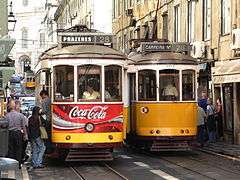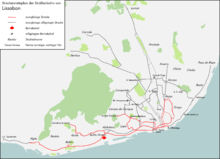Trams in Lisbon
 Two Remodelado trams on line 28. | |||||||||||||||||||||
| Operation | |||||||||||||||||||||
|---|---|---|---|---|---|---|---|---|---|---|---|---|---|---|---|---|---|---|---|---|---|
| Locale | Lisbon, Portugal | ||||||||||||||||||||
| |||||||||||||||||||||
| |||||||||||||||||||||
The Lisbon tramway network (Portuguese: Rede de eléctricos de Lisboa) serves the municipality of Lisbon, capital city of Portugal. In operation since 1873, it presently comprises five urban lines.
History

The first tramway in Lisbon entered service on 17 November 1873, as a horsecar line. On 30 August 1901, Lisbon's first electric tramway commenced operations. Within a year, all of the city's tramways had been converted to electric traction.
Up until 1959, the network of lines was further developed, and in that year it reached its greatest extent. At that time, there was a total of 27 tram lines in Lisbon, of which six operated as circle lines. As the circle lines operated in both clockwise and anticlockwise directions, each with its own route number, it is more correct to speak of a total of 24 tram routes, all of them running on 900 mm (2 ft 11 7⁄16 in) narrow gauge tram lines.
The construction of the Lisbon Metro and the expansion of the bus system began the slow decline of the network.
Current network
The current lines are:
- 12 - Praça da Figueira - Miradouro de Santa Luzia circular route (clockwise only)
- 15 - Praça da Figueira - Algés
- 18 - Cais do Sodré railway station - Cemitério Ajuda
- 25 - R. Alfândega - Campo de Ourique
- 28 - Praça Martim Moniz - Chiado - Campo de Ourique
The five remaining lines only operate in the southern centre and west of the city. Despite the relevant tourist attraction, those lines are still very important because of sections of the city's topography that can only be crossed by small trams. Tram 15 also connects the entire western river front of the city to the centre and allows a better flow of passengers with the bus system towards an area that still is not served by the metro.
Although reports prepared by both the École Polytechnique Fédérale de Lausanne and the Verkehrsbetriebe Zürich concluded that the network should be retained and even extended, the process of decline has continued. However, some work has recently been done on preparing the Carmo–Campolide line for reopening.
Rolling stock
The vehicles used are:
- 'Articulado' trams made by Siemens (Siemens/CAF nos 501-506 and Siemens/Sorefame nos 507-510). These articulated vehicles were introduced in 1995, and run only on route 15.
- 'Remodelado' trams (nos 541-585) used on all five routes
- Tourist trams used on some routes
See also
References
Notes
Books
- King, B R; Price, J H (1995). The Tramways of Portugal (4th ed.). London: Light Rail Transit Association. ISBN 0-948106-19-0.
- Tavares Dias, Marina (2001). História do eléctrico da Carris: The history of the Lisbon trams. Lisboa: Quimera. ISBN 972-589-066-3. (Portuguese) (English)
Website
- Laidlar, John. "Lisbon Trams, Part One: Trams of Today". Luso Pages website. Laidlar, John. Retrieved 10 March 2011. External link in
|work=(help) - Laidlar, John. "Lisbon Trams, Part Two: Trams of The Past". Luso Pages website. Laidlar, John. Retrieved 10 March 2011. External link in
|work=(help)
External links
| Wikimedia Commons has media related to Trams in Lisbon. |
This article is based upon a translation of the German language version as at March 2011.

